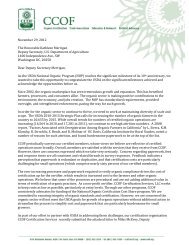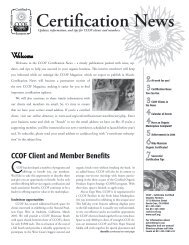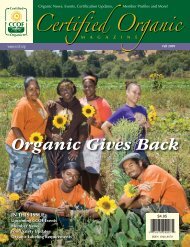Herstory: Women in Organic Agriculture - CCOF
Herstory: Women in Organic Agriculture - CCOF
Herstory: Women in Organic Agriculture - CCOF
Create successful ePaper yourself
Turn your PDF publications into a flip-book with our unique Google optimized e-Paper software.
Conventional growers have obvious<br />
recourse aga<strong>in</strong>st the beetles—pesticides<br />
such as “7” (Carbaryl)—but even they<br />
must be careful to choose a spray that does<br />
not affect honeybees, as melons rely on the<br />
<strong>in</strong>sects for poll<strong>in</strong>ation. Many organic growers<br />
can treat their crops, too, with Pyrethrum<br />
and other plant-based pesticides. But California,<br />
with its str<strong>in</strong>gent standards, disallows<br />
most such sprays. Smaller plant<strong>in</strong>gs<br />
can use float<strong>in</strong>g row covers to shield young<br />
plants from the bugs, but on a scale like<br />
Durst’s, the method is cost-prohibitive.<br />
So Durst just tries to stay one step ahead<br />
of the bug. He rotates the fields where he<br />
grows melons. And s<strong>in</strong>ce the beetles do the<br />
worst damage when they “eat faster than the<br />
plant can grow,” he plants when the v<strong>in</strong>es<br />
can mature fastest. In fall, when the nearly<br />
ripe melons lie beside fallow fields whose<br />
crops have been harvested, the plants are<br />
once aga<strong>in</strong> prey to the green beetles. And<br />
at that po<strong>in</strong>t, Durst just crosses his f<strong>in</strong>gers.<br />
WATER<br />
As desert plants, melons have a peculiar<br />
relationship with water. They are naturally<br />
equipped to deal with arid conditions, their<br />
roots able to reach for water deep down <strong>in</strong><br />
the earth. Dave Fredericks uses this to his<br />
advantage by nearly dry-farm<strong>in</strong>g his n<strong>in</strong>e<br />
acres of melons, water<strong>in</strong>g the crop only a<br />
couple times over the three-month grow<strong>in</strong>g<br />
period. He expla<strong>in</strong>s, “The way they nest <strong>in</strong><br />
the ground, it’s natural for them to be on dry<br />
land. If the ground were wet, they’d rot.”<br />
While Jim Durst waters his 100 acres<br />
more regularly, by means of drip tape irrigation,<br />
he is also careful to control the flow.<br />
Because melons will take whatever you give<br />
them, too much too close to their fruit’s<br />
maturity means a melon that is all water.<br />
So, about two weeks before they pick, Durst<br />
beg<strong>in</strong>s withhold<strong>in</strong>g, forc<strong>in</strong>g his plants to<br />
consider how they will propagate themselves<br />
as the lifel<strong>in</strong>e is cut. They react by concentrat<strong>in</strong>g<br />
their sugars <strong>in</strong> the fruit, ensur<strong>in</strong>g<br />
that creatures like us will be more likely to<br />
eat them and disperse their seeds.<br />
SELECTING THE PERFECT MELON<br />
Short of pick<strong>in</strong>g it yourself, how can you tell<br />
a good melon? First rule is simple: despite<br />
what people say about brown bags and<br />
bananas, no melon will ripen off the v<strong>in</strong>e.<br />
They will decompose and soften, but never<br />
are they as sweet as the moment they are<br />
picked. The trick is f<strong>in</strong>d<strong>in</strong>g one that’s neither<br />
too old nor too young.<br />
Knock<strong>in</strong>g works on watermelon, but you<br />
must have a highly tra<strong>in</strong>ed ear. As Jim Durst<br />
says, “It’s like tun<strong>in</strong>g a guitar—you have to<br />
know what you’re listen<strong>in</strong>g for to get it right.”<br />
Squeez<strong>in</strong>g is a good method for cull<strong>in</strong>g bad<br />
melons, for the smooth end softens as the<br />
fruit <strong>in</strong>side starts to rot and lose flavor. Likewise,<br />
shak<strong>in</strong>g can signal danger; if you hear<br />
anyth<strong>in</strong>g rattl<strong>in</strong>g <strong>in</strong>side, it means the seeds<br />
are sw<strong>in</strong>g<strong>in</strong>g free and the fruit is no good.<br />
But f<strong>in</strong>d<strong>in</strong>g a perfectly ripe melon is<br />
more difficult than simply avoid<strong>in</strong>g the<br />
bad ones. First, you must understand how<br />
the fruits ripen. Many melons are said to<br />
“slip” off their v<strong>in</strong>es when ready, mean<strong>in</strong>g<br />
the stems crack and detach<strong>in</strong>g them is<br />
effortless. Jim Durst harvests this way,<br />
visit<strong>in</strong>g his plant<strong>in</strong>g each day and pick<strong>in</strong>g<br />
only the ripe fruit. (When grown on a<br />
much larger scale, melons are picked <strong>in</strong><br />
one sweep, many before they are ready.)<br />
A clean severance at the stem end means<br />
the melon was picked on time.<br />
Dave Fredericks gets<br />
even more personal with<br />
his melons. He employs<br />
the Japanese “T” cut, a<br />
method by which he<br />
looks both at the fruit’s<br />
stem and the tendril that<br />
grows <strong>in</strong>dependently of<br />
it from the same notch<br />
<strong>in</strong> the v<strong>in</strong>e. When the<br />
tendril dries out and<br />
curls up, he slices the<br />
fruit from the v<strong>in</strong>e,<br />
leav<strong>in</strong>g stem and tendril<br />
attached. Last of all, he<br />
sniffs them, as everyone<br />
should. Like roses, he<br />
says, melons smell for<br />
only three days. If your<br />
prospective fruit has no<br />
odor, it was picked too<br />
early or has been sitt<strong>in</strong>g<br />
too long. But if it does<br />
have an aroma, Fredericks<br />
has only one suggestion:<br />
don’t waste any time—<br />
grab a spoon and dig <strong>in</strong>.<br />
Conventional Melon Grow<strong>in</strong>g<br />
M<br />
elons would seem to be clean of agrichemicals<br />
once they reach the table, s<strong>in</strong>ce the part<br />
we eat is protected by a thick shell. Alas, it’s not that<br />
simple. Melon plants <strong>in</strong>gest agrichemicals systemically;<br />
for <strong>in</strong>stance, a cantaloupe plant might absorb<br />
a pesticide through its leaves, roots, and stem.<br />
S<strong>in</strong>ce those parts channel water and nutrients to the<br />
fruit, the juicy <strong>in</strong>side can still conta<strong>in</strong> the toxic<br />
chemical even if the spray never touched it directly.<br />
The top chemicals used for California melons are<br />
the fumigants 1,3-dichloropropene and Metamsodium,<br />
which are <strong>in</strong>jected <strong>in</strong>to the soil before plant<strong>in</strong>g<br />
<strong>in</strong> order to kill off nematodes and weeds that<br />
might threaten the v<strong>in</strong>es down the road. As Pesticide<br />
Action Network outl<strong>in</strong>es <strong>in</strong> its report “Hooked on<br />
Poison,” melon growers have <strong>in</strong>creased their use of<br />
fumigants steadily s<strong>in</strong>ce the early ’90s. Not good<br />
news for melon eaters, s<strong>in</strong>ce both 1,3-dichloropropene<br />
and Metam-sodium are carc<strong>in</strong>ogens and<br />
the former a ground water contam<strong>in</strong>ant.<br />
The pesticides that are sprayed aim ma<strong>in</strong>ly to<br />
rid crops of the cucumber beetle. Most popular<br />
are Carbaryl, which is made from napthalene (the<br />
ma<strong>in</strong> <strong>in</strong>gredient <strong>in</strong> moth balls), Methomyl, and<br />
Diaz<strong>in</strong>on. All are neurotox<strong>in</strong>s and potential<br />
groundwater contam<strong>in</strong>ants; the latter a developmental<br />
and reproductive toxicant and the other<br />
two suspected endocr<strong>in</strong>e disruptors.<br />
Summer 2002 Page 17

















